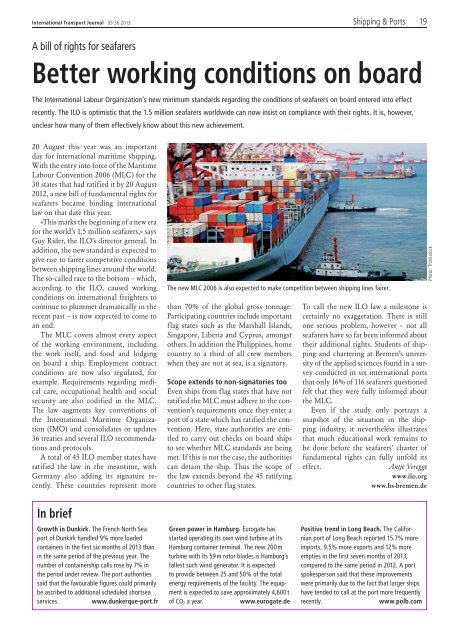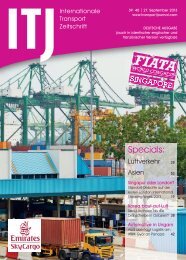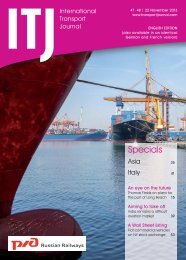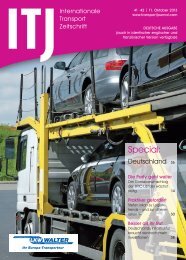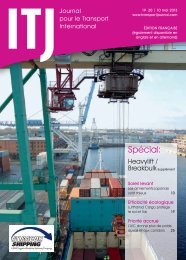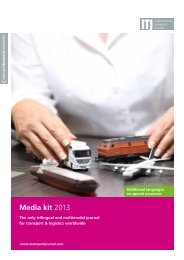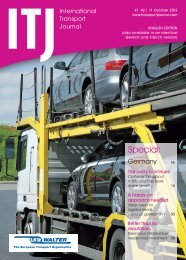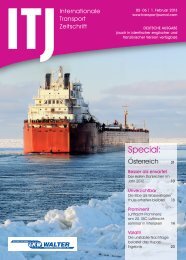Specials - ITJ | Transport Journal
Specials - ITJ | Transport Journal
Specials - ITJ | Transport Journal
- No tags were found...
Create successful ePaper yourself
Turn your PDF publications into a flip-book with our unique Google optimized e-Paper software.
International <strong>Transport</strong> <strong>Journal</strong> 35-36 2013 Shipping & Ports19A bill of rights for seafarersBetter working conditions on boardThe International Labour Organization’s new minimum standards regarding the conditions of seafarers on board entered into effectrecently. The ILO is optimistic that the 1.5 million seafarers worldwide can now insist on compliance with their rights. It is, however,unclear how many of them effectively know about this new achievement.20 August this year was an importantday for international maritime shipping.With the entry into force of the MaritimeLabour Convention 2006 (MLC) for the30 states that had ratified it by 20 August2012, a new bill of fundamental rights forseafarers became binding internationallaw on that date this year.«This marks the beginning of a new erafor the world’s 1.5 million seafarers,» saysGuy Rider, the ILO’s director general. Inaddition, the new standard is expected togive rise to fairer competitive conditionsbetween shipping lines around the world.The so-called race to the bottom – which,according to the ILO, caused workingconditions on international freighters tocontinue to plummet dramatically in therecent past – is now expected to come toan end.The MLC covers almost every aspectof the working environment, includingthe work itself, and food and lodgingon board a ship. Employment contractconditions are now also regulated, forexample. Requirements regarding medicalcare, occupational health and socialsecurity are also codified in the MLC.The law augments key conventions ofthe International Maritime Organization(IMO) and consolidates or updates36 treaties and several ILO recommendationsand protocols.A total of 45 ILO member states haveratified the law in the meantime, withGermany also adding its signature recently.These countries represent moreThe new MLC 2006 is also expected to make competition between shipping lines fairer.than 70% of the global gross tonnage.Participating countries include importantflag states such as the Marshall Islands,Singapore, Liberia and Cyprus, amongstothers. In addition the Philippines, homecountry to a third of all crew memberswhen they are not at sea, is a signatory.Scope extends to non-signatories tooEven ships from flag states that have notratified the MLC must adhere to the convention’srequirements once they enter aport of a state which has ratified the convention.Here, state authorities are entitledto carry out checks on board shipsto see whether MLC standards are beingmet. If this is not the case, the authoritiescan detain the ship. Thus the scope ofthe law extends beyond the 45 ratifyingcountries to other flag states.To call the new ILO law a milestone iscertainly no exaggeration. There is stillone serious problem, however – not allseafarers have so far been informed abouttheir additional rights. Students of shippingand chartering at Bremen’s universityof the applied sciences found in a surveyconducted in six international portsthat only 16% of 116 seafarers questionedfelt that they were fully informed aboutthe MLC.Even if the study only portrays asnapshot of the situation in the shippingindustry, it nevertheless illustratesthat much educational work remains tobe done before the seafarers’ charter offundamental rights can fully unfold itseffect.Antje Vereggewww.ilo.orgwww.hs-bremen.dePhoto: ThinkstockIn briefGrowth in Dunkirk. The French North Seaport of Dunkirk handled 9% more loadedcontainers in the first six months of 2013 thanin the same period of the previous year. Thenumber of containership calls rose by 7% inthe period under review. The port authoritiessaid that the favourable figures could primarilybe ascribed to additional scheduled shortseaservices.www.dunkerque-port.frGreen power in Hamburg. Eurogate hasstarted operating its own wind turbine at itsHamburg container terminal. The new 200 mturbine with its 59 m rotor blades is Hamburg’stallest such wind generator. It is expectedto provide between 25 and 50% of the totalenergy requirements of the facility. The equipmentis expected to save approximately 4,600tof CO 2 a year.www.eurogate.dePositive trend in Long Beach. The Californianport of Long Beach reported 15.7% moreimports, 9.5% more exports and 12% moreempties in the first seven months of 2013,compared to the same period in 2012. A portspokesperson said that these improvementswere primarily due to the fact that larger shipshave tended to call at the port more frequentlyrecently.www.polb.com


